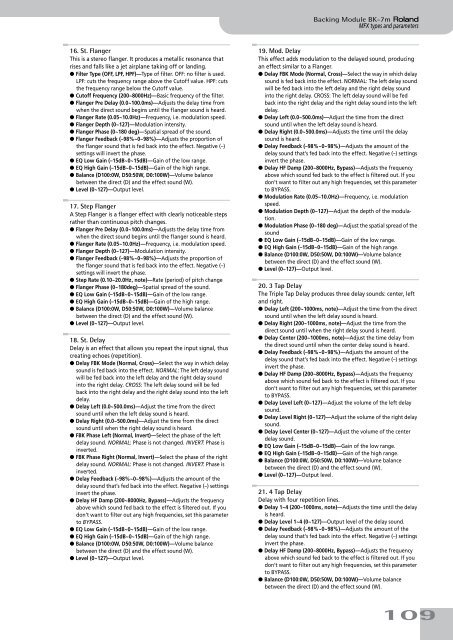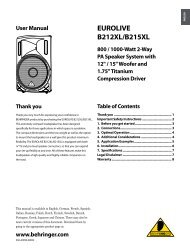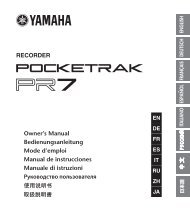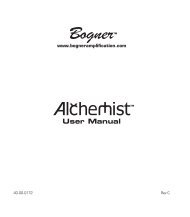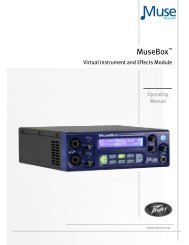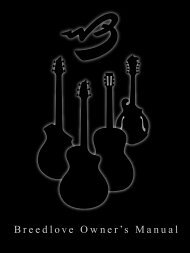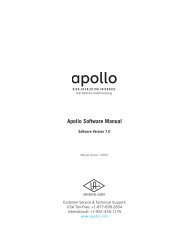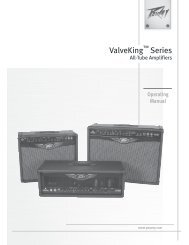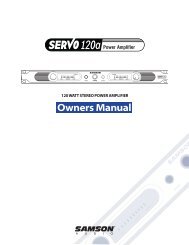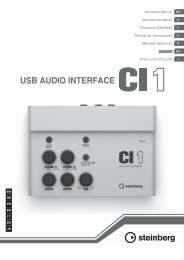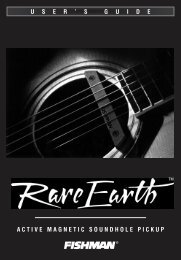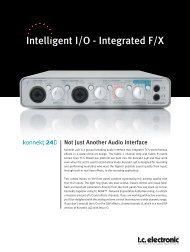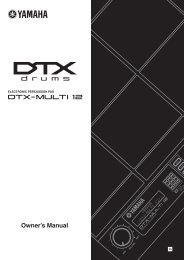Create successful ePaper yourself
Turn your PDF publications into a flip-book with our unique Google optimized e-Paper software.
Backing Module <strong>BK</strong>-<strong>7m</strong> r<br />
MFX types and parameters<br />
16. St. Flanger<br />
This is a stereo flanger. It produces a metallic resonance that<br />
rises and falls like a jet airplane taking off or landing.<br />
● Filter Type (OFF, LPF, HPF)—Type of filter. OFF: no filter is used.<br />
LPF: cuts the frequency range above the Cutoff value. HPF: cuts<br />
the frequency range below the Cutoff value.<br />
● Cutoff Frequency (200~8000Hz)—Basic frequency of the filter.<br />
● Flanger Pre Delay (0.0~100.0ms)—Adjusts the delay time from<br />
when the direct sound begins until the flanger sound is heard.<br />
● Flanger Rate (0.05~10.0Hz)—Frequency, i.e. modulation speed.<br />
● Flanger Depth (0~127)—Modulation intensity.<br />
● Flanger Phase (0~180 deg)—Spatial spread of the sound.<br />
● Flanger Feedback (–98%~0~98%)—Adjusts the proportion of<br />
the flanger sound that is fed back into the effect. Negative (–)<br />
settings will invert the phase.<br />
● EQ Low Gain (–15dB~0~15dB)—Gain of the low range.<br />
● EQ High Gain (–15dB~0~15dB)—Gain of the high range.<br />
● Balance (D100:0W, D50:50W, D0:100W)—Volume balance<br />
between the direct (D) and the effect sound (W).<br />
● Level (0~127)—Output level.<br />
17. Step Flanger<br />
A Step Flanger is a flanger effect with clearly noticeable steps<br />
rather than continuous pitch changes.<br />
● Flanger Pre Delay (0.0~100.0ms)—Adjusts the delay time from<br />
when the direct sound begins until the flanger sound is heard.<br />
● Flanger Rate (0.05~10.0Hz)—Frequency, i.e. modulation speed.<br />
● Flanger Depth (0~127)—Modulation intensity.<br />
● Flanger Feedback (–98%~0~98%)—Adjusts the proportion of<br />
the flanger sound that is fed back into the effect. Negative (–)<br />
settings will invert the phase.<br />
● Step Rate (0.10~20.0Hz, note)—Rate (period) of pitch change<br />
● Flanger Phase (0~180deg)—Spatial spread of the sound.<br />
● EQ Low Gain (–15dB~0~15dB)—Gain of the low range.<br />
● EQ High Gain (–15dB~0~15dB)—Gain of the high range.<br />
● Balance (D100:0W, D50:50W, D0:100W)—Volume balance<br />
between the direct (D) and the effect sound (W).<br />
● Level (0~127)—Output level.<br />
18. St. Delay<br />
Delay is an effect that allows you repeat the input signal, thus<br />
creating echoes (repetition).<br />
● Delay F<strong>BK</strong> Mode (Normal, Cross)—Select the way in which delay<br />
sound is fed back into the effect. NORMAL: The left delay sound<br />
will be fed back into the left delay and the right delay sound<br />
into the right delay. CROSS: The left delay sound will be fed<br />
back into the right delay and the right delay sound into the left<br />
delay.<br />
● Delay Left (0.0~500.0ms)—Adjust the time from the direct<br />
sound until when the left delay sound is heard.<br />
● Delay Right (0.0~500.0ms)—Adjust the time from the direct<br />
sound until when the right delay sound is heard.<br />
● F<strong>BK</strong> Phase Left (Normal, Invert)—Select the phase of the left<br />
delay sound. NORMAL: Phase is not changed. INVERT: Phase is<br />
inverted.<br />
● F<strong>BK</strong> Phase Right (Normal, Invert)—Select the phase of the right<br />
delay sound. NORMAL: Phase is not changed. INVERT: Phase is<br />
inverted.<br />
● Delay Feedback (–98%~0~98%)—Adjusts the amount of the<br />
delay sound that’s fed back into the effect. Negative (–) settings<br />
invert the phase.<br />
● Delay HF Damp (200~8000Hz, Bypass)—Adjusts the frequency<br />
above which sound fed back to the effect is filtered out. If you<br />
don’t want to filter out any high frequencies, set this parameter<br />
to BYPASS.<br />
● EQ Low Gain (–15dB~0~15dB)—Gain of the low range.<br />
● EQ High Gain (–15dB~0~15dB)—Gain of the high range.<br />
● Balance (D100:0W, D50:50W, D0:100W)—Volume balance<br />
between the direct (D) and the effect sound (W).<br />
● Level (0~127)—Output level.<br />
19. Mod. Delay<br />
This effect adds modulation to the delayed sound, producing<br />
an effect similar to a Flanger.<br />
● Delay F<strong>BK</strong> Mode (Normal, Cross)—Select the way in which delay<br />
sound is fed back into the effect. NORMAL: The left delay sound<br />
will be fed back into the left delay and the right delay sound<br />
into the right delay. CROSS: The left delay sound will be fed<br />
back into the right delay and the right delay sound into the left<br />
delay.<br />
● Delay Left (0.0~500.0ms)—Adjust the time from the direct<br />
sound until when the left delay sound is heard.<br />
● Delay Right (0.0~500.0ms)—Adjusts the time until the delay<br />
sound is heard.<br />
● Delay Feedback (–98%~0~98%)—Adjusts the amount of the<br />
delay sound that’s fed back into the effect. Negative (–) settings<br />
invert the phase.<br />
● Delay HF Damp (200~8000Hz, Bypass)—Adjusts the frequency<br />
above which sound fed back to the effect is filtered out. If you<br />
don’t want to filter out any high frequencies, set this parameter<br />
to BYPASS.<br />
● Modulation Rate (0.05~10.0Hz)—Frequency, i.e. modulation<br />
speed.<br />
● Modulation Depth (0~127)—Adjust the depth of the modulation.<br />
● Modulation Phase (0~180 deg)—Adjust the spatial spread of the<br />
sound<br />
● EQ Low Gain (–15dB~0~15dB)—Gain of the low range.<br />
● EQ High Gain (–15dB~0~15dB)—Gain of the high range.<br />
● Balance (D100:0W, D50:50W, D0:100W)—Volume balance<br />
between the direct (D) and the effect sound (W).<br />
● Level (0~127)—Output level.<br />
20. 3 Tap Delay<br />
The Triple Tap Delay produces three delay sounds: center, left<br />
and right.<br />
● Delay Left (200~1000ms, note)—Adjust the time from the direct<br />
sound until when the left delay sound is heard.<br />
● Delay Right (200~1000ms, note)—Adjust the time from the<br />
direct sound until when the right delay sound is heard.<br />
● Delay Center (200~1000ms, note)—Adjust the time delay from<br />
the direct sound until when the center delay sound is heard.<br />
● Delay Feedback (–98%~0~98%)—Adjusts the amount of the<br />
delay sound that’s fed back into the effect. Negative (–) settings<br />
invert the phase.<br />
● Delay HF Damp (200~8000Hz, Bypass)—Adjusts the frequency<br />
above which sound fed back to the effect is filtered out. If you<br />
don’t want to filter out any high frequencies, set this parameter<br />
to BYPASS.<br />
● Delay Level Left (0~127)—Adjust the volume of the left delay<br />
sound.<br />
● Delay Level Right (0~127)—Adjust the volume of the right delay<br />
sound.<br />
● Delay Level Center (0~127)—Adjust the volume of the center<br />
delay sound.<br />
● EQ Low Gain (–15dB~0~15dB)—Gain of the low range.<br />
● EQ High Gain (–15dB~0~15dB)—Gain of the high range.<br />
● Balance (D100:0W, D50:50W, D0:100W)—Volume balance<br />
between the direct (D) and the effect sound (W).<br />
● Level (0~127)—Output level.<br />
21. 4 Tap Delay<br />
Delay with four repetition lines.<br />
● Delay 1~4 (200~1000ms, note)—Adjusts the time until the delay<br />
is heard.<br />
● Delay Level 1~4 (0~127)—Output level of the delay sound.<br />
● Delay Feedback (–98%~0~98%)—Adjusts the amount of the<br />
delay sound that’s fed back into the effect. Negative (–) settings<br />
invert the phase.<br />
● Delay HF Damp (200~8000Hz, Bypass)—Adjusts the frequency<br />
above which sound fed back to the effect is filtered out. If you<br />
don’t want to filter out any high frequencies, set this parameter<br />
to BYPASS.<br />
● Balance (D100:0W, D50:50W, D0:100W)—Volume balance<br />
between the direct (D) and the effect sound (W).<br />
109


